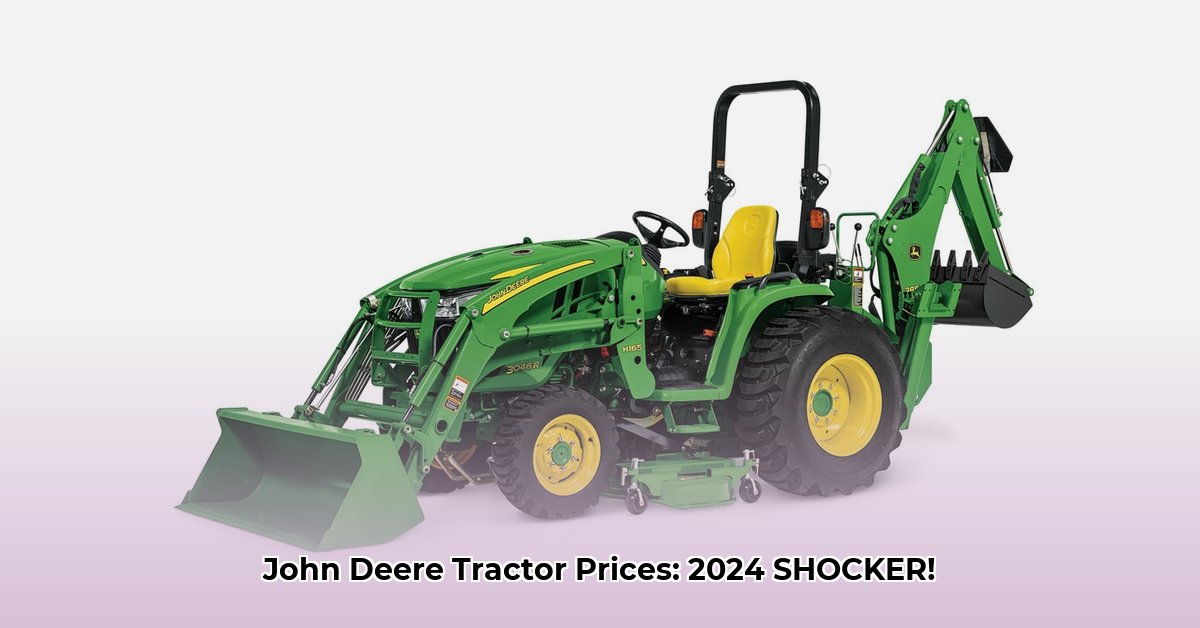
Investing in a John Deere tractor is a significant decision for any farmer, impacting both productivity and profitability. This comprehensive guide explores the multifaceted cost landscape of John Deere tractors, equipping you with the knowledge to make an informed choice. We'll examine factors influencing purchase price, explore ongoing operational costs, delve into financing options, and consider the critical role of sustainability in your investment. For more information on John Deere ride-on tractors, check out this helpful resource: [John Deere Ride-Ons](https://john-deere-ride-on-tractors.pages.dev).
Factors Affecting John Deere Tractor Costs
The cost of a John Deere tractor isn't a single figure; it’s a variable influenced by several key factors. Understanding these factors is crucial for aligning your investment with your operational needs and budget.
Horsepower: The Foundation of Performance and Price
Horsepower (HP) is the primary determinant of a tractor's capabilities and, consequently, its price. A small, low-horsepower tractor suitable for a hobby farm might cost between $9,000 and $35,000. Conversely, high-horsepower tractors used in large-scale operations can easily exceed $600,000. Higher horsepower translates to greater efficiency for demanding tasks, but this enhanced power comes at a premium.
Features: Enhancing Functionality, Increasing Cost
Modern tractors offer a range of features that enhance efficiency and precision. Four-wheel drive (4WD), GPS-guided systems, and automatic steering systems significantly improve operational precision but also increase the purchase price. Evaluate essential versus luxury features to balance performance with your budget. Advanced technologies, while increasing the initial cost, often lead to long-term cost savings through increased efficiency.
Condition: New vs. Used – A Cost-Benefit Analysis
Buying a new tractor guarantees peak performance and warranty coverage, but comes with a higher upfront cost. Used tractors offer significant initial savings, yet potential maintenance and repair costs should be carefully considered. A thorough pre-purchase inspection is essential to avoid hidden problems. Choosing wisely balances initial cost against potential long-term expenses. How much more expensive is a new tractor compared to a used one? The difference can reach tens of thousands of dollars depending on the model and age.
Age: Depreciation's Impact on Value
Like vehicles, tractors depreciate over time. Older models are generally cheaper but may require more frequent and potentially costly maintenance. Balancing the lower initial cost with increased repair risks is paramount. This trade-off warrants diligent assessment factoring in potential maintenance expenses to prevent unexpected breakdowns.
Attachments: Adding to the Total Cost
Don't overlook the costs of essential attachments such as plows, mowers, and loaders. These implements significantly influence the overall investment. Thoroughly assess your operational needs and budget accordingly to factor these additional costs into your total expenses.
John Deere Tractor Price Ranges: A Categorical Overview
While precise pricing varies by model, features, and location, the following table provides a general overview based on tractor categories:
| Tractor Type | Approximate Price Range (USD) | Typical Use Cases |
|---|---|---|
| Compact Tractors | $9,000 - $35,000 | Small farms, hobby farms, landscaping, homeowners |
| Utility Tractors | $30,000 - $120,000 | Medium-sized farms, diverse tasks, livestock operations |
| High-Horsepower Tractors | $100,000 - $600,000+ | Large-scale farming, commercial operations, specialized tasks |
Note: These are estimates; consult authorized John Deere dealers for up-to-date pricing. Remember to factor in taxes and delivery costs. What additional expenses are unaccounted for in the initial purchase price? Insurance, maintenance, and repairs are all recurring costs.
Operational Costs: Beyond the Initial Investment
The initial purchase price represents only a portion of the total cost of ownership. Ongoing operational costs, such as fuel, maintenance, repairs, and insurance, are significant components, often surpassing the initial investment over the tractor's lifespan.
Fuel Consumption: A Major Ongoing Expense
Diesel fuel is a substantial expense. Fuel efficiency varies depending on the tractor's size, features, and farming practices. Employing fuel-efficient driving techniques and utilizing precision farming technologies can mitigate these substantial costs. What strategies can reduce fuel consumption in sustainable farming? Regularly scheduled maintenance and adopting more efficient farming practices are crucial in managing fuel expenses.
Maintenance: Preventative Care for Long-Term Savings
Regular maintenance is key to preventing costly breakdowns. Scheduling routine servicing, including oil changes, filter replacements, and inspections, minimizes unexpected repair expenses and maximizes the tractor's lifespan. How much can preventative maintenance save on unexpected repairs? A proactive approach can prevent costly repairs and extend the tractor's operational lifespan, saving far more than the maintenance costs themselves.
Repairs: Addressing the Unexpected
Despite preventative maintenance, unexpected repairs are unavoidable. Budgeting for potential breakdowns is crucial to ensure continuous and uninterrupted operation. Financial preparedness for such contingencies is essential. What are the most common repair needs for John Deere tractors? Common issues vary based on tractor model and usage, and regular maintenance significantly mitigates these issues.
Insurance: Protecting Your Investment
Comprehensive insurance is vital to protect your significant investment. The cost is influenced by the tractor's value and your location. Adequate insurance coverage ensures financial protection against unforeseen events, such as accidents or theft.
Sustainability: Integrating Environmental Responsibility into Your Investment
Sustainable farming practices are gaining increasing importance. Fuel-efficient tractors contribute to reducing environmental impact and operational costs. Exploring alternative fuels, such as biodiesel, presents potential long-term cost savings and reduced emission profiles, though infrastructure limitations remain a challenge.
Financing Options and Affordability
Securing financing is crucial for many farmers. Various financing options exist, including loans and leasing, often tailored to farmers' needs and financial situations. Government programs and cooperatives frequently offer subsidies, grants, or financing support to promote sustainable farming practices, making the purchase more accessible.
Conclusion: Making an Informed Decision
Choosing the right John Deere tractor requires meticulous planning and analysis. Consider the initial purchase price alongside long-term operational costs, including fuel, maintenance, and repairs, while factoring in the increasing importance of environmentally sustainable practices. Thorough research, consultations with dealers, and careful budgeting are vital for a successful investment. Remember, the purchase price is just one element within a larger long-term cost equation.